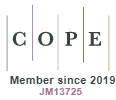Submissions
Submission Preparation Checklist
As part of the submission process, authors are required to check off their submission's compliance with all of the following items, and submissions may be returned to authors that do not adhere to these guidelines.- Neither the submission has been previously published, nor it is in another journal for consideration.
- The submission file is in OpenOffice, Microsoft Word, or RTF document file format.
- Where available, URLs for the references have been provided.
- All illustrations, figures, and tables are placed within the text at the appropriate places, rather than at the end.
- The text adheres to the stylistic and bibliographic requirements outlined in the Author Guidelines.
Copyright Notice
View Legal Code of the above mentioned license, https://creativecommons.org/licenses/by/4.0/legalcode
View Licence Deed here https://creativecommons.org/licenses/by/4.0/
 |
Journal of Chemistry, Environmental Sciences and its Applications by Chitkara University Publications is licensed under a Creative Commons Attribution 4.0 International License. Based on a work at https://jce.chitkara.edu.in |
Privacy Statement
The names and email addresses entered in this journal site will be used exclusively for the stated purposes of this journal and will not be made available for any other purpose or to any other party.






